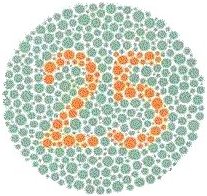
Pseudoisochromatic plates frequently are used by eye specialists to get an idea of one’s color efficiency or deficiency. The Ishihara color test, used to detect protanopia and deuteranopia color deficiencies, was designed by Dr. Shinobu Ishihara (1879–1963), a professor at the University of Tokyo.
The test includes several pseudoisochromatic plates, each composed of a pattern of differently shaded dots. Within each pattern, a number is present.
To a color-deficient person, all the dots in one or more of the plates will appear similar or the same—“isochromatic.” To a person without a color deficiency, some of the dots will appear dissimilar enough from the other dots to form a distinct figure (number) on each of the plates—“pseudoisochromatic.”
In the following plate, even a color-deficient person will be able to distinguish an orange “25” on a turquoise background:

In the table below, click on each of the twelve links to view a new pseudoisochromatic plate. Try to determine what number is encompassed within each plate; then go to the answer to see if you are correct.
Afterwards, close the small window and return to this page to link to the next pseudoisochromatic plate. Some of the numbers are difficult to see, even for people with normal color vision. Just do your best!
| Plate #1 | Plate #2 | Plate #3 | Plate #4 |
| Plate #5 | Plate #6 | Plate #7 | Plate #8 |
| Plate #9 | Plate #10 | Plate #11 | Plate #12 |
| Plate #13 | Plate #14 | Plate #15 | Plate #16 |
If you missed being able to detect the
Go to Anatomy, Physiology & Pathology of the Human Eye ![]()
Return to Macula ![]()
Return to Ted’s HOMEPAGE ![]()
![]()
Copyright © 1998– by Ted M. Montgomery, O.D. Most rights reserved.